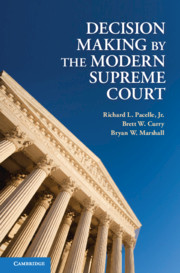Book contents
- Frontmatter
- Contents
- Acknowledgments
- 1 The Supreme Court
- 2 Heuristic Models of Judicial Decision Making
- 3 Building an Integrated Model of Decision Making
- 4 Decision Making on the Modern Supreme Court
- 5 Building a New Legacy
- 6 Sharing the Protection of Minorities
- 7 Avoiding Another Self-Inflicted Wound
- 8 Policing the Boundaries
- 9 Conclusion
- Measurement Appendix
- Cases Cited
- References
- Index
9 - Conclusion
Decision Making on the Modern Supreme Court
Published online by Cambridge University Press: 05 June 2012
- Frontmatter
- Contents
- Acknowledgments
- 1 The Supreme Court
- 2 Heuristic Models of Judicial Decision Making
- 3 Building an Integrated Model of Decision Making
- 4 Decision Making on the Modern Supreme Court
- 5 Building a New Legacy
- 6 Sharing the Protection of Minorities
- 7 Avoiding Another Self-Inflicted Wound
- 8 Policing the Boundaries
- 9 Conclusion
- Measurement Appendix
- Cases Cited
- References
- Index
Summary
Is the Supreme Court a bevy of Platonic guardians or the keepers of the covenant, or is it the nation's balance wheel? Does the Court perform a constitutional soliloquy, or is it part of a colloquy in building doctrine? It depends on whom you ask. Attempts to define Supreme Court decision making are vaguely reminiscent of the parable of the blind men and the elephant. The parable, which has many versions (kind of like studies of judicial decision making) in many cultures (like the different approaches), maintains that a number of blind men (from four to nine, depending on the source) are asked to identify an elephant. Each touches the elephant in a different place, so each has a different interpretation. To the one who touches only the leg, it is a tree; to another touching only the trunk, it is a snake; still another grasps the tail and believes the elephant is a rope.
We think many of the existing models resemble this parable. Some analysts have stated a normative view of what decision making should be like but ignore the empirical realities. Others drop unanimous cases and make a judgment despite that limited perspective. Some look at the individual level and try to generalize to the institutional level. We have tried to circumnavigate the elephant and get a broader perspective. As a result, we conclude that no single explanation or model is useful in understanding all decision making.
- Type
- Chapter
- Information
- Decision Making by the Modern Supreme Court , pp. 199 - 214Publisher: Cambridge University PressPrint publication year: 2011



